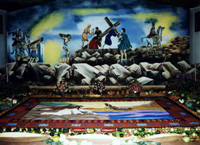 Photo.
Photo. A
beautiful carpent on the wall in Antigua.
The Easter
does something with people. They get livelier. The rest of the year
Antigua in Guatemala is a tranquil, idyllic town with 28.000 inhabitants, and
a varying number of foreigners studying Spanish. It is located in the highlands, and with its colonial style
buildings, its view to three magnificent volcanoes, its many markets, churches and cafés, it's
a perfect, peaceful place to spend a few days - which could easily turn
into weeks, as it did for me.
But for Easter Week things change and the city really comes to life. Visitors
and faithful from far and near come to view the religious processions, and so do
most of the pickpockets from Guatemala City.
The custom of religious processions dates back to the
sixteenth century and was brought to Guatemala by the Spanish conquerors. Today the celebration of
Lent and Easter Week in Antigua is second only to Seville, Spain.
Each procession leaves from one specific church. Thousands of cucuruchos, processional carriers, take part
in these traditions.
The floats with the sculpture of Jesus are carried by up to 80 men. Carriers
change at each block. The procession begins with incense carriers, and a funeral
band follows the float. When you smell the incense and hear the funeral marches
you know the procession is approaching.
| Photo. The floats with the sculpture of
Jesus. This has very strong symbolic
effects. |
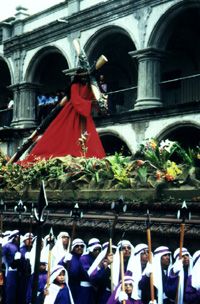 |
|
Photo. Preparation.
Sometimes the carpet is completed only minutes before the float
approaches. |
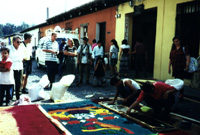 |
|
Photo. A long colourful carpet. The design is
imressing! |
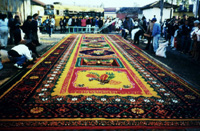 |
Designs
are drawn, sawdust bought and dyed, stencils are made out of heavy cardboard and
so on. This traditional activity brings neighbours and friends together, and
unites the neighbourhood in a common task. The carpets are either made of pine
needles and flower petals, or coloured sawdust. The most impressive carpets are
made for the Good Friday procession, and can take 10 - 20 hours to make.
You must know when the procession passes by your house, and how long it will
take to make the carpet. Sometimes the carpet is completed only minutes before
the float approaches. This is not the right time to unleash your dog
Carpets
are also made for the Sundays in lent.
One Sunday the students of my school made a carpet outside the school
building. First we prepared the pine needles and the flowers, picking of the
heads of red carnations, yellow chrysanthemums and many others. Then we had to
wait for the street to be closed for traffic. The street was covered with the
pine needles and the flower petals were arranged in a pattern on top. This took
a couple of hours, and when we had finished we all agreed that ours` was the
best in the street. Then we sat there waiting for the procession, proud when
people passing by, took pictures of our alfombra.
The float is heavy and progress isn't exactly quick. It was dark by the time
it reached our street. Finally we saw the first Roman soldiers and noticed the
first smell of incense. Then came a group of men wearing long, pointed red hats,
their faces covered. In the dark, with the fog from the incense and the funeral
music it was almost a bit spooky. Next came hordes of carriers in purple robes,
and finally, what we were waiting for, the float with the statue of Jesus. The
carriers of the float are the first who are allowed to walk over the
carpet.
|
Photo: Roman soldiers. Is this the longest
carpent here? |
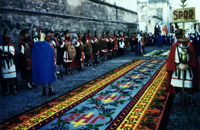 |
After the main float came the women, carrying a smaller float with the
sculpture of the Virgin Mary. When the last funeral band passed not much was
left of our well-trodden carpet. This was the happy end of a great cultural and
social experience!
Kari Evandt, 7 December 2000
Additional
information
Formal country name:
Republic of
Guatemala.
Area: 109,000 sq km.
Population: 11.7
million.
People: 56% mestizo/ladino descent, 44%
Mayan descent.
Language: Spanish;
Castilian.
Religion: Roman Catholic, Pentecostal,
Mayan-Catholic fusion.
Government: constitutional
democratic republic.
Guatemala is the Mayan heartland of Central
America. Have you seen the fantastic
pyramids in the jungle?
Read more
about the Mayan culture on our website.
